The lower drawers are going to be mostly larger, heavier items like transformers, controls, and hardware.
I'm 6ft 3in tall, my limit is a lot higher than 3ft, even now.
I figured out years ago that if I wanted to get rid of something that the trash won't take you just put a for sale sign on it and leave it out over night, it'll be gone in the morning.
If not, I've got a backhoe..
The items that I'll need to really scrutinize are the large jars of used parts. There are thousands of bridge rectifiers, transistors, inductor coils, variable capacitors from radios, and knobs that he saved.
I'm 6ft 3in tall, my limit is a lot higher than 3ft, even now.
I figured out years ago that if I wanted to get rid of something that the trash won't take you just put a for sale sign on it and leave it out over night, it'll be gone in the morning.
If not, I've got a backhoe..
The items that I'll need to really scrutinize are the large jars of used parts. There are thousands of bridge rectifiers, transistors, inductor coils, variable capacitors from radios, and knobs that he saved.
Two weeks into this mess and I'm finally, maybe done finding and sorting through all the 1/4 to 1w carbon and metal film resistors. I sorted but only boxed the carbon composite resistors for now, which amounted to about 40 lbs or so of them.
I bought a roll of 5x3" plastic bags and am nearly through a full roll. The good part is that in the larger cabinets, in bags, they take up a fraction of the room they did in all the small drawers. So far I eliminated about 25 of those small cabinets.
What I did for the resistors was to make up small bags of 150 count for each value and organized them in one cabinet going from low to high with four sections per drawer, each with a set range. It gave me 16 large drawers of 1/4 watt resistors. The 1/2 watt assortment didn't cover as many sizes so they took only 4 drawers. Larger resistors will be set up in four more drawers at below those.
I also got through most of the non-electrolytic capacitors, which took 20 drawers as well. The electrolytics may stay their own cabinet on the bench, as will the smaller value caps that would be too easily lost in the larger drawers.
Next is the transistors. Right now the few that are in the larger cabinet are grouped as either NPN or PNP in any one drawer, but not by part number.
Its made sorting them so far a real pain. I also am finding far more part numbers than I had first thought. I'm up to about 550 p/n's so far in just the tiny transistors, not counting the TO-3 and TO-220 types, triacs, or voltage regulators.
What I'd like to do is to sort them all in sequential order by part number, at least those that carry a 2NXXXX type number. There's a good many RCA branded or other p/n's too. The majority though are Motorola or Texas Instruments branded.
I've also been bagging and tagging all the diodes and bridge rectifiers, so far the diodes alone are up to four large drawers, and I'll likely need to add four more for just diodes. That will mean moving all or any of the op-amps or IC's out of the larger drawers into their own smaller cabinet. Which may make more sense as each p/n is less numerous than other components. So far I've filled one 60 drawer cabinets with just IC's, mostly all computer or CMOS chips. Some dating back to the mid 70's. I also found a good many early PC processors from the 80's.
After all this so far, I've still not tackled the large tubs, which appear to be mostly capacitors, transformers, and supplies. There's one whole 30 gallon Rubbermaid tub full of orange Sprague caps, another full of white and aluminum Mallory caps, and one with a mix of Panasonic and Rubycon caps.
The few I grabbed and tested seemed fine, but that's to be determined. Their age varies. The whole lot ranges from the late 1940's to about 20010 or so judging by the receipts I found.
The receipts are mostly from Mouser, Digikey, Reynolds, Motorola, and Radio Shack Industrial. (I never knew Radio Shack had a bulk supply line). The RS receipts range from 1980 to 1997 or so. The Mouser receipts range from 1951 to 2009, and Digikey mostly in the 80's and 90's.
He saved everything, but the receipts are often not all itemized. He bought bulk lots of things, all huge quantities.
It makes no sense to me why because he was pretty much just a home tinkerer, I'm pretty sure he was a teacher by trade. The electronics were just a hobby.
There's also a lot of items here that I can't ID at all, small coils, inverter transformers, small titanium parts, massive amounts of small stainless screws ranging from #12 down to micron sized screws too small to handle without tweezers.
So far though my biggest amazement is in the shear quantities of certain small transistors. To put this in perspective, a 5oz Dixie cup holds about 2,500 2N5457 transistors, how many are in a cardboard barrel the size of a bar stool that's filled to the top. Then figure there's 12 barrels of 11 other part numbers. I'd venture to guess that most suppliers wouldn't keep that number in stock, let alone a guy who worked out of his house. Even one 4x12" drawer full of any one p/n would be far more than a lifetime supply for most shops, let alone one guy who at best tinkered with a few items per week or month. I did not find the barrels on any of the receipts but did find a crude inventory that included them in 1988. Then there's the small plastic box assortments which hold about 6 p/n's each in about a 9x12" box. There are over 60 of those assortments, many never opened. Some have sat so long the plastic has turned brittle. Many of the trays have the Motorola logo right in the plastic. The numbers in large quantities so far are 2N5457, 2N5460, 2N5458, 2N5459, 2N3904, 2N3906, 2N2222, 2N5756, 2N5758, and about 10 or so other p/n's. The rest are mostly in 500 to 1,500 quantities. The same with a handful of resistor values, some are far more numerous than others. for some reason he had a shoe box size box full of 3.9m 1/4w resistors and rolls of 5,250 180 ohm 1w metal film resistors.
There's also a good many solderless connectors in the lot, but nothing common, all are odd styles, including a few in military bags which are marked 'platinum', as well as two boxes of neon dash indicators for various military aircraft. There's also several Aircraft radios in the lot, but all are older, nothing newer than than the early 70's, a few from the 30's and 40's as well. One tub is full of military aircraft dash gauges. The 9 330 yd rolls of various diameter heat shrink tubing will certainly come in handy though.
My original plan of going through all this in a few days is long past and out the window, its looking like a year long project now that will tie up my garage, basement, two spare rooms, and two trailers and my camper for the duration. I don't want to just pack it all away not knowing what all is here because it'll just sit. I want to clear out the useless items and sell off the large quantity items and knock it all down to a manageable size somehow.
The amount it will save me by not having to special order things a handful at a time will no doubt pay off over the years to come.
What bugs me though is that after I had already gotten the first lot of stuff here, I still found myself ordering parts because I simply couldn't find anyting in all the boxes that were at the time still packed in the trailer. As found it would fill a 53ft tractor/trailer box and maybe then some. It needs to get down to a lot that takes up no more than a few shelves in the house and maybe one wall in the basement or garage.
I did clean out two of these larger bins that he had, most were full of used items, but he saved everything, good or bad. The bright green one was full of old wax capacitors and used tube sockets.
The light gray cabinet is full of electrolytic caps, large wire wound resistors, and large switches. The four Akron boxes are full of small hardware and weigh in at well over a 100lbs each. There are thirty of these cabinets in all but only enough good drawers to for about 20 of them and a few of them are pretty well battered from either being overloaded or dropped. The goal is to make up four good stacks of them 5 boxes tall each, on wheels. so they can be moved easily.
The metal cabinets will stay in the garage or basement for used parts or other items. I see no good reason to use them for small parts, nor do I intend to save that much stuff here.
There are two of the green cabinets, and five of the gray cabinets. Each of them were in the guy's basement when I found them.
As i go through all this stuff I only wish it were more audio oriented, but most of it is rather generic.
In the end though, there was no way I could refuse it for free.
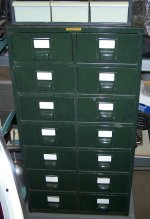
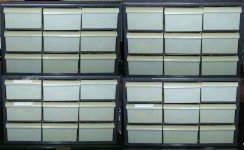

I bought a roll of 5x3" plastic bags and am nearly through a full roll. The good part is that in the larger cabinets, in bags, they take up a fraction of the room they did in all the small drawers. So far I eliminated about 25 of those small cabinets.
What I did for the resistors was to make up small bags of 150 count for each value and organized them in one cabinet going from low to high with four sections per drawer, each with a set range. It gave me 16 large drawers of 1/4 watt resistors. The 1/2 watt assortment didn't cover as many sizes so they took only 4 drawers. Larger resistors will be set up in four more drawers at below those.
I also got through most of the non-electrolytic capacitors, which took 20 drawers as well. The electrolytics may stay their own cabinet on the bench, as will the smaller value caps that would be too easily lost in the larger drawers.
Next is the transistors. Right now the few that are in the larger cabinet are grouped as either NPN or PNP in any one drawer, but not by part number.
Its made sorting them so far a real pain. I also am finding far more part numbers than I had first thought. I'm up to about 550 p/n's so far in just the tiny transistors, not counting the TO-3 and TO-220 types, triacs, or voltage regulators.
What I'd like to do is to sort them all in sequential order by part number, at least those that carry a 2NXXXX type number. There's a good many RCA branded or other p/n's too. The majority though are Motorola or Texas Instruments branded.
I've also been bagging and tagging all the diodes and bridge rectifiers, so far the diodes alone are up to four large drawers, and I'll likely need to add four more for just diodes. That will mean moving all or any of the op-amps or IC's out of the larger drawers into their own smaller cabinet. Which may make more sense as each p/n is less numerous than other components. So far I've filled one 60 drawer cabinets with just IC's, mostly all computer or CMOS chips. Some dating back to the mid 70's. I also found a good many early PC processors from the 80's.
After all this so far, I've still not tackled the large tubs, which appear to be mostly capacitors, transformers, and supplies. There's one whole 30 gallon Rubbermaid tub full of orange Sprague caps, another full of white and aluminum Mallory caps, and one with a mix of Panasonic and Rubycon caps.
The few I grabbed and tested seemed fine, but that's to be determined. Their age varies. The whole lot ranges from the late 1940's to about 20010 or so judging by the receipts I found.
The receipts are mostly from Mouser, Digikey, Reynolds, Motorola, and Radio Shack Industrial. (I never knew Radio Shack had a bulk supply line). The RS receipts range from 1980 to 1997 or so. The Mouser receipts range from 1951 to 2009, and Digikey mostly in the 80's and 90's.
He saved everything, but the receipts are often not all itemized. He bought bulk lots of things, all huge quantities.
It makes no sense to me why because he was pretty much just a home tinkerer, I'm pretty sure he was a teacher by trade. The electronics were just a hobby.
There's also a lot of items here that I can't ID at all, small coils, inverter transformers, small titanium parts, massive amounts of small stainless screws ranging from #12 down to micron sized screws too small to handle without tweezers.
So far though my biggest amazement is in the shear quantities of certain small transistors. To put this in perspective, a 5oz Dixie cup holds about 2,500 2N5457 transistors, how many are in a cardboard barrel the size of a bar stool that's filled to the top. Then figure there's 12 barrels of 11 other part numbers. I'd venture to guess that most suppliers wouldn't keep that number in stock, let alone a guy who worked out of his house. Even one 4x12" drawer full of any one p/n would be far more than a lifetime supply for most shops, let alone one guy who at best tinkered with a few items per week or month. I did not find the barrels on any of the receipts but did find a crude inventory that included them in 1988. Then there's the small plastic box assortments which hold about 6 p/n's each in about a 9x12" box. There are over 60 of those assortments, many never opened. Some have sat so long the plastic has turned brittle. Many of the trays have the Motorola logo right in the plastic. The numbers in large quantities so far are 2N5457, 2N5460, 2N5458, 2N5459, 2N3904, 2N3906, 2N2222, 2N5756, 2N5758, and about 10 or so other p/n's. The rest are mostly in 500 to 1,500 quantities. The same with a handful of resistor values, some are far more numerous than others. for some reason he had a shoe box size box full of 3.9m 1/4w resistors and rolls of 5,250 180 ohm 1w metal film resistors.
There's also a good many solderless connectors in the lot, but nothing common, all are odd styles, including a few in military bags which are marked 'platinum', as well as two boxes of neon dash indicators for various military aircraft. There's also several Aircraft radios in the lot, but all are older, nothing newer than than the early 70's, a few from the 30's and 40's as well. One tub is full of military aircraft dash gauges. The 9 330 yd rolls of various diameter heat shrink tubing will certainly come in handy though.
My original plan of going through all this in a few days is long past and out the window, its looking like a year long project now that will tie up my garage, basement, two spare rooms, and two trailers and my camper for the duration. I don't want to just pack it all away not knowing what all is here because it'll just sit. I want to clear out the useless items and sell off the large quantity items and knock it all down to a manageable size somehow.
The amount it will save me by not having to special order things a handful at a time will no doubt pay off over the years to come.
What bugs me though is that after I had already gotten the first lot of stuff here, I still found myself ordering parts because I simply couldn't find anyting in all the boxes that were at the time still packed in the trailer. As found it would fill a 53ft tractor/trailer box and maybe then some. It needs to get down to a lot that takes up no more than a few shelves in the house and maybe one wall in the basement or garage.
I did clean out two of these larger bins that he had, most were full of used items, but he saved everything, good or bad. The bright green one was full of old wax capacitors and used tube sockets.
The light gray cabinet is full of electrolytic caps, large wire wound resistors, and large switches. The four Akron boxes are full of small hardware and weigh in at well over a 100lbs each. There are thirty of these cabinets in all but only enough good drawers to for about 20 of them and a few of them are pretty well battered from either being overloaded or dropped. The goal is to make up four good stacks of them 5 boxes tall each, on wheels. so they can be moved easily.
The metal cabinets will stay in the garage or basement for used parts or other items. I see no good reason to use them for small parts, nor do I intend to save that much stuff here.
There are two of the green cabinets, and five of the gray cabinets. Each of them were in the guy's basement when I found them.
As i go through all this stuff I only wish it were more audio oriented, but most of it is rather generic.
In the end though, there was no way I could refuse it for free.



Its now been over a month since I started this whole deal here.
Yesterday I thought I saw the light at the end of the tunnel when I finally emptied the last small drawer cabinet and had what I thought was everything in the larger Akron bins. At that point I was thinking that all that was left was to label a few drawers and maybe re-organize a few items in numerical order to make them easier to find.
So far there's 30 Akron cabinets, each with 16 drawers, plus 7 60 drawer boxes which contain all the IC chips and Op Amps, arranged in numerical order.

Basically I put the larger items in the bottom set of drawers, transformers, switches, large capacitors, etc.
Then starting from the top in the the first cabinet, I assigned ranges to each drawer and put all the resistors in the two three drawers in the
first four cabinets, starting with 1/8w, then 1/4w, and so on. Each cabinet ended up with the top 20 drawers being resistor assortments in each wattage up to 10w. Then the next drawers are for transistors, in numerical order, by type, small transistors in the first two, then t-220 types, then TO-3 types, then brand specific numbers in the last two. Below the transistors I put the diodes, again separated by type, then in numerical order low to high. That took 12 drawers per tower, then the rest of the drawers are for capacitors, first by type, then by value, with the last cabinet having varistors, relays, and LED and Panel lights in the remaining drawers.
It was looking really good.

The whole sorting project has left me with about 250 empty small drawer cabinets so far, I've got stacks of them everywhere.
I do plan to use a few for things like fuse assortments, bulb assortments, and some hardware and a few will go on my work bench for small parts in the basement wood shop. One thing is for sure I'll never have to buy one of these cabinets again as long as I live.
Then...tonight, the guy's daughter shows up with her minivan and drops off 19 more tubs of parts.
two tubs of resistors, five with electrolytic caps, two with IC chips, more rolls of resistors, boxes of transformers, and four tubs of some type of amplifier kits. Something similar to an old Heathkit deal but from a company called Southtech. Each kit has all the resistors, capacitors, but no transistors and no power supply. I only glanced at them so far, they look small, with two T0-3 transistor spots on each board which is about 4x6" or so. The boards are fiberglass and the kits look fairly old, early 70's or so. The resistors in the kits are all Carbon Composition.
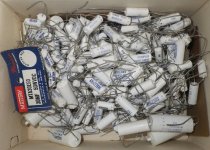
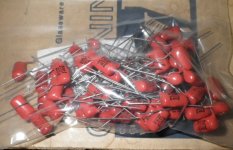
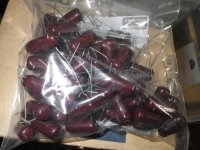
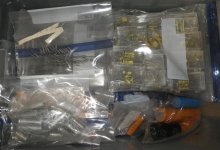
There are several boxes/cases of these white Mallory caps, plus large numbers of the epoxy caps and smaller Sprague and Mallory assortments. The few I did test so far seem to test fine.
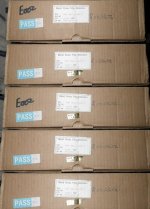
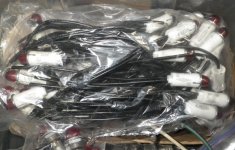
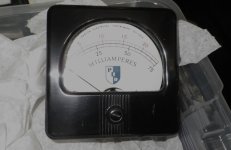
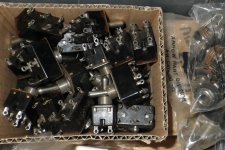
Boxes of resistors on rolls - Panel Indicator lamps, many different types - Milliamp gauges, - sevderal cases of switches, all the same, and some DPDT 1/4" headphone jacks
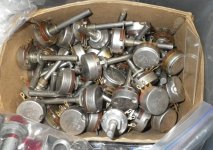
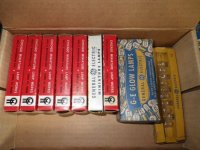
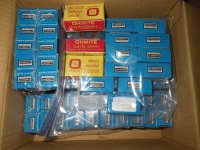
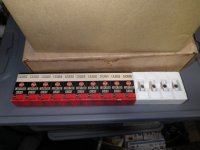
Large box of variable resistors - Light bulbs - more variable resistors - RCA IC chips
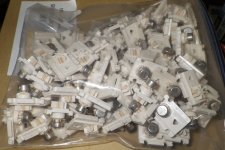
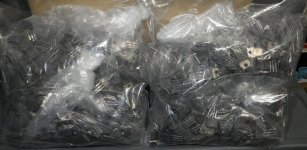
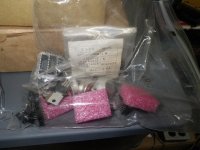
Unknown 6 lead op amps or transistors-tub full of transistors marked PF-AR-17 274 KE-7021? - tub full of odd assortment of parts in bags
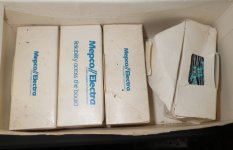
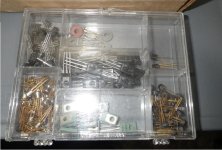
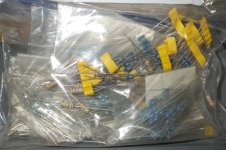
2 cases of Mepco Metal Film Resistors. - More odd assortments, all sealed in plastic boxes, 79 of them in all, all identical - Tub full of more 1/4 and 1/2w resistors, unsorted, about 40 lbs of them in 1 gal bags like shown here.
After thinking I was nearly done two days ago, now I'm looking at a few more days of bagging and sorting.
None of what is in the stacks of Akron bins include the bulk lots of many p/n's. I still have the cardboard barrels of various transistors and large boxes of items like shown above.
Keep in mind that most of this all came out of some old guys house. Most of which was stored in a few spare bedrooms he wasn't using.
About 1/4 of it came from several storage lockers he was renting. This last lot was in one of those lockers. My guess is that he ran out of space in the house and started renting space. It seems the newer items are coming from the storage lockers.
I'm seeing brands that I've not seen before, and a lot of suppliers that I never new existed.
Some of the receipts I'm finding are from Powell Electronics in Phila, PA, Alma Electronics Corp, Phila, PA Roberts Electronics in NJ,
Summit Electronics in NJ, plus about 30 others. All of the orders are huge and were shipped to his home. A few are clearance or surplus type sellers, or at least they are now, but the majority of the smaller orders are from Digikey and Mouser.
There are quite a few kits from various companies, a few are amps, a few are for power supplies, a few are for test equipment.
So far I've gone though four rolls of 2250 3x5" poly bags, and have to order more. I find it easier to have everything in bags in the drawers, that way its easier to just grab a bag and take what I need, then seal it up and put it back in the right slot. It keeps things sorted as they should be.
What I still need to work on, once everything is bagged, is to arrange and re-label each drawer in numerical order vs by type as most were before.
I completely redid the resistors and caps, but the transistors ended up being the most numerous part number wise and took the most drawers. Some drawers just got duplicates added to them, but the new drawers I added are in order but not permanently tagged yet.
Yesterday I thought I saw the light at the end of the tunnel when I finally emptied the last small drawer cabinet and had what I thought was everything in the larger Akron bins. At that point I was thinking that all that was left was to label a few drawers and maybe re-organize a few items in numerical order to make them easier to find.
So far there's 30 Akron cabinets, each with 16 drawers, plus 7 60 drawer boxes which contain all the IC chips and Op Amps, arranged in numerical order.
Basically I put the larger items in the bottom set of drawers, transformers, switches, large capacitors, etc.
Then starting from the top in the the first cabinet, I assigned ranges to each drawer and put all the resistors in the two three drawers in the
first four cabinets, starting with 1/8w, then 1/4w, and so on. Each cabinet ended up with the top 20 drawers being resistor assortments in each wattage up to 10w. Then the next drawers are for transistors, in numerical order, by type, small transistors in the first two, then t-220 types, then TO-3 types, then brand specific numbers in the last two. Below the transistors I put the diodes, again separated by type, then in numerical order low to high. That took 12 drawers per tower, then the rest of the drawers are for capacitors, first by type, then by value, with the last cabinet having varistors, relays, and LED and Panel lights in the remaining drawers.
It was looking really good.
The whole sorting project has left me with about 250 empty small drawer cabinets so far, I've got stacks of them everywhere.
I do plan to use a few for things like fuse assortments, bulb assortments, and some hardware and a few will go on my work bench for small parts in the basement wood shop. One thing is for sure I'll never have to buy one of these cabinets again as long as I live.
Then...tonight, the guy's daughter shows up with her minivan and drops off 19 more tubs of parts.
two tubs of resistors, five with electrolytic caps, two with IC chips, more rolls of resistors, boxes of transformers, and four tubs of some type of amplifier kits. Something similar to an old Heathkit deal but from a company called Southtech. Each kit has all the resistors, capacitors, but no transistors and no power supply. I only glanced at them so far, they look small, with two T0-3 transistor spots on each board which is about 4x6" or so. The boards are fiberglass and the kits look fairly old, early 70's or so. The resistors in the kits are all Carbon Composition.




There are several boxes/cases of these white Mallory caps, plus large numbers of the epoxy caps and smaller Sprague and Mallory assortments. The few I did test so far seem to test fine.




Boxes of resistors on rolls - Panel Indicator lamps, many different types - Milliamp gauges, - sevderal cases of switches, all the same, and some DPDT 1/4" headphone jacks




Large box of variable resistors - Light bulbs - more variable resistors - RCA IC chips



Unknown 6 lead op amps or transistors-tub full of transistors marked PF-AR-17 274 KE-7021? - tub full of odd assortment of parts in bags



2 cases of Mepco Metal Film Resistors. - More odd assortments, all sealed in plastic boxes, 79 of them in all, all identical - Tub full of more 1/4 and 1/2w resistors, unsorted, about 40 lbs of them in 1 gal bags like shown here.
After thinking I was nearly done two days ago, now I'm looking at a few more days of bagging and sorting.
None of what is in the stacks of Akron bins include the bulk lots of many p/n's. I still have the cardboard barrels of various transistors and large boxes of items like shown above.
Keep in mind that most of this all came out of some old guys house. Most of which was stored in a few spare bedrooms he wasn't using.
About 1/4 of it came from several storage lockers he was renting. This last lot was in one of those lockers. My guess is that he ran out of space in the house and started renting space. It seems the newer items are coming from the storage lockers.
I'm seeing brands that I've not seen before, and a lot of suppliers that I never new existed.
Some of the receipts I'm finding are from Powell Electronics in Phila, PA, Alma Electronics Corp, Phila, PA Roberts Electronics in NJ,
Summit Electronics in NJ, plus about 30 others. All of the orders are huge and were shipped to his home. A few are clearance or surplus type sellers, or at least they are now, but the majority of the smaller orders are from Digikey and Mouser.
There are quite a few kits from various companies, a few are amps, a few are for power supplies, a few are for test equipment.
So far I've gone though four rolls of 2250 3x5" poly bags, and have to order more. I find it easier to have everything in bags in the drawers, that way its easier to just grab a bag and take what I need, then seal it up and put it back in the right slot. It keeps things sorted as they should be.
What I still need to work on, once everything is bagged, is to arrange and re-label each drawer in numerical order vs by type as most were before.
I completely redid the resistors and caps, but the transistors ended up being the most numerous part number wise and took the most drawers. Some drawers just got duplicates added to them, but the new drawers I added are in order but not permanently tagged yet.
holy crow a bag of original gangsta 741 op amps!!!!
with trying to id some of this stuff it may be useful to find some vintage Sylvania ECG Cross References
Last edited:
Simply amazing that someone would accumulate that many parts in a lifetime. Good luck even trying to sell them off because I can’t see you using much of it in your lifetime. One way or the other it’s a lot of work cheers too you.
I've only taken pics of a small part of it all, the scale of all this stuff is mind boggling to me, even after more than a month of dealing with it all. More so that most of it was in the guys house. If you had walked in the front door nothing seemed odd but the back rooms were packed. The living room was fairly well kept, as was the kitchen but he had turned one bedroom into a workshop of sorts. It was shelved wall to wall with a long bench on on wall and a half dozen parts bin carts in the middle being used for storage as well two bedrooms were shelved out and packed to the ceiling as well. Plus the basement, garage, attic, four closets, and so far, 9 storage lockers he was renting.
What is even more mind boggling is the used parts, there was 9 tubs of used components that had been carefully unsoldered and sorted into plastic mayonnaise jars. One 20 gallon tub was filled with nothing but used larger bridge rectifiers, another is all used capacitors, another is all large wire wound resistors, some over a foot long. Another tub is split with half being used toggle switches, and other being full of large dual function variable resistors
One box I opened today, about a 12" cube, is full of crystals, but all are super high frequency, 12k and over. all appear used.
In the large tubs, he made wood supports to hold the weight, he cut wooden bottoms for each tub, and cut dividers that fit perfectly to the sides which he glued in place with what looks like marine urethane.
The last lot is mostly smaller tubs, about 5 gallon or so. most are full of op amps and larger transistors.
One medium size tub is filled with #241 RCA transistors, about 80 lbs of them.
The 741 op amps shown are a small bag found in one of the tubs, there's also a large barrel of them. Somewhere he got hold of a bunch of those 35 gallon recycling cans and was using them to store things in in the basement. He lined the cans with heavy poly bags, then filled the cans and heat shrinked the bag closed. Those cans are HEAVY, one bent the bottom plate on my handtruck trying to move it.
His daughter showed up today again and I knew I was in trouble when I realized how low her van was sitting. She had about 40 more small tubs full of more parts. Mostly all IC chips and more RCA op amps. Plus one full of 1 ohm 9" long by about 3/4" round wire wound resistors, another full of new, multi tap transformers, and another two tubs of square ceramic resistors in 1, 5, and 10 ohm.
Plus two full tubs of epoxy 'gum drop' capacitors. All of those are 100va and 600v in 1% tolerance.
Another tub was filled with more metal film resistors ranging from 10Ω to 15m, 5w. Plus a full case of those Mepco 681k metal film resistors and 12 more rolls of the same 5 and 10w .33Ω resis
tors on rolls.
I do have some books here that he had but none are cross reference books, just spec sheets on various components. There's probably 300 or so books in all, plus boxes of circuit design, component usage, and similar books as well. They're in a bunch of those glass door stereo rack cabinets and were along one wall in his living room.
One box she brought over today was full of more small Motorola transistors, all in 100 lots packaged in brown envelopes from "Nesco Electronics, Div. of Radio Electric Service of PA". The box is about 24x18x20" deep and contains five '100 count' packs of each value, all are small black transistors, such as 2N3904. 2N3906, 2N5460, 2N5210, 2N5087, 2N5486, 2N5457, 2N5459. 2N2222A, plus a half dozen or so more numbers that I'm finding in large numbers, including a few barrels of a couple types.
When I first started this I knew it was going to be a huge lot of stuff, but never once did I imagine it was going to be this big. This isn't 'personal hoarder' quantities, many of these parts are apparently the inventories of a few major manufacturers.
What I don't understand is why he had it all. he wasn't trying to sell it, and wen I went there, usually as a last resort, getting him to part with what I needed was like pulling teeth. Most of the time he wouldn't take any money, which is another reason I didn't make a habit of going there. Never once in all the years I knew of him there did I think he had any serious quantity of parts, all I ever saw was a few shelves of small parts bins through the door. He wouldn't let anyone inside, at least not past the side door, he would take your list, tell you to wait right there by the door, and he'd disappear into the back room and sooner or later come back with what you needed. Then you had to bargain with him over what they were worth, but most of the time he wouldn't take any cash, he just led you to think you were negotiating a price.
Looking at all the receipts, most of these parts were bought new by him, so he had money in them. They weren't just salvage or surplus he bought up because it was cheap. I quit going there because as he got older, his mind wasn't as sharp and I got the impression he didn't want to be bothered. If you went there with a list, he'd sometimes just grab what ever he had, often completely unrelated items and hand them to you. Either he just wanted to get rid of you or he was losing his faculties due to age.
I'm not sure how old he was but his daughter who contacted me told me she was born the while her dad was over in Korea in the early 50's and the house there was his parents place before that.
He never offered much information, nor does his daughter.
I do get the feeling that if I hadn't taken this all she would have either paid someone to remove it or put it all out on the curb and walked away. A common way to dump items here is to take them to the flea market and just leave what don't sell behind. It happens all the time.
Here's a few of the boards out of those kit boxes:
each board is about 6x3 inches or so
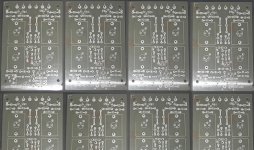

one of jar of used rectifiers:
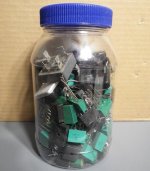
he must have eaten a lot of mayonnaise, theres over 300 jars full of parts,
What is even more mind boggling is the used parts, there was 9 tubs of used components that had been carefully unsoldered and sorted into plastic mayonnaise jars. One 20 gallon tub was filled with nothing but used larger bridge rectifiers, another is all used capacitors, another is all large wire wound resistors, some over a foot long. Another tub is split with half being used toggle switches, and other being full of large dual function variable resistors
One box I opened today, about a 12" cube, is full of crystals, but all are super high frequency, 12k and over. all appear used.
In the large tubs, he made wood supports to hold the weight, he cut wooden bottoms for each tub, and cut dividers that fit perfectly to the sides which he glued in place with what looks like marine urethane.
The last lot is mostly smaller tubs, about 5 gallon or so. most are full of op amps and larger transistors.
One medium size tub is filled with #241 RCA transistors, about 80 lbs of them.
The 741 op amps shown are a small bag found in one of the tubs, there's also a large barrel of them. Somewhere he got hold of a bunch of those 35 gallon recycling cans and was using them to store things in in the basement. He lined the cans with heavy poly bags, then filled the cans and heat shrinked the bag closed. Those cans are HEAVY, one bent the bottom plate on my handtruck trying to move it.
His daughter showed up today again and I knew I was in trouble when I realized how low her van was sitting. She had about 40 more small tubs full of more parts. Mostly all IC chips and more RCA op amps. Plus one full of 1 ohm 9" long by about 3/4" round wire wound resistors, another full of new, multi tap transformers, and another two tubs of square ceramic resistors in 1, 5, and 10 ohm.
Plus two full tubs of epoxy 'gum drop' capacitors. All of those are 100va and 600v in 1% tolerance.
Another tub was filled with more metal film resistors ranging from 10Ω to 15m, 5w. Plus a full case of those Mepco 681k metal film resistors and 12 more rolls of the same 5 and 10w .33Ω resis
tors on rolls.
I do have some books here that he had but none are cross reference books, just spec sheets on various components. There's probably 300 or so books in all, plus boxes of circuit design, component usage, and similar books as well. They're in a bunch of those glass door stereo rack cabinets and were along one wall in his living room.
One box she brought over today was full of more small Motorola transistors, all in 100 lots packaged in brown envelopes from "Nesco Electronics, Div. of Radio Electric Service of PA". The box is about 24x18x20" deep and contains five '100 count' packs of each value, all are small black transistors, such as 2N3904. 2N3906, 2N5460, 2N5210, 2N5087, 2N5486, 2N5457, 2N5459. 2N2222A, plus a half dozen or so more numbers that I'm finding in large numbers, including a few barrels of a couple types.
When I first started this I knew it was going to be a huge lot of stuff, but never once did I imagine it was going to be this big. This isn't 'personal hoarder' quantities, many of these parts are apparently the inventories of a few major manufacturers.
What I don't understand is why he had it all. he wasn't trying to sell it, and wen I went there, usually as a last resort, getting him to part with what I needed was like pulling teeth. Most of the time he wouldn't take any money, which is another reason I didn't make a habit of going there. Never once in all the years I knew of him there did I think he had any serious quantity of parts, all I ever saw was a few shelves of small parts bins through the door. He wouldn't let anyone inside, at least not past the side door, he would take your list, tell you to wait right there by the door, and he'd disappear into the back room and sooner or later come back with what you needed. Then you had to bargain with him over what they were worth, but most of the time he wouldn't take any cash, he just led you to think you were negotiating a price.
Looking at all the receipts, most of these parts were bought new by him, so he had money in them. They weren't just salvage or surplus he bought up because it was cheap. I quit going there because as he got older, his mind wasn't as sharp and I got the impression he didn't want to be bothered. If you went there with a list, he'd sometimes just grab what ever he had, often completely unrelated items and hand them to you. Either he just wanted to get rid of you or he was losing his faculties due to age.
I'm not sure how old he was but his daughter who contacted me told me she was born the while her dad was over in Korea in the early 50's and the house there was his parents place before that.
He never offered much information, nor does his daughter.
I do get the feeling that if I hadn't taken this all she would have either paid someone to remove it or put it all out on the curb and walked away. A common way to dump items here is to take them to the flea market and just leave what don't sell behind. It happens all the time.
Here's a few of the boards out of those kit boxes:
each board is about 6x3 inches or so


one of jar of used rectifiers:

he must have eaten a lot of mayonnaise, theres over 300 jars full of parts,
After considering many different options for organizing parts, I have come to the conclusion that paper coin envelopes are the best solution---MUCH more efficient than small drawers that always seem to get mixed up or spilled.
I've gone through three rolls of 2250 3x5" poly bags so far, most of them on resistors and transistors. I need to find about 6,000 more.
What seems to work is multiply dividers in the larger Akron drawers with each item in small bags with the value printed in a tag inside the bag.
I gave up trying to inventory quantities, nearly all items are in 5k or higher quantities.
Sat. morning his daughter dropped off more stuff, this lot was in 4 large tubs and about 40 small clear flip top tubs.
The tubs are full of small assortments all in little plastic clam shells with 5 pieces each. I can't say if he was making up small assortments to sell or if he bought these like this from someone, but they make little sense in the whole realm of things here.
Two tubs are full of plastic jars full of resistors, which I believe are carbon film type but are brick red in color.
They test out to nearly identical to what they're marked, less than .1 ohm off from the rating on any of them.
All are 1/2w and 1w in values started at 1 ohm up to 1m, so there's quite a few jars of them. Another tub has black resistors with the values marked in white print, every last one of those are in odd specific values, like 273.5 Ω or 971.8 Ω or similar. They too run a wide range with little overlap, and every last one reads exactly what its marked. Those are marked 1% tolerance.
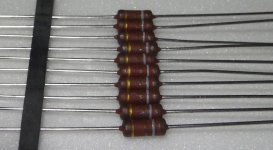
1/2w 180Ω carbon film resistors?

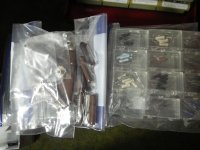
Note the bags of wire wound resistors, there are boxes of these in various colors or types,
The one tub had to weigh 100 lbs or more.
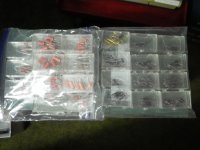
Small boxes, about 1x2" or so each with 5 pcs, in it. There are dozens of each 'kit'.
Good suggestion on the Sylvania cross reference, after some digging, it turns out there is a couple of them in the lot of books. One is from 1978, the other from 1980. When I looked up what it was I recognized the cover and remembered boxing up one just like it.
(There's a few hundred books in all, many are duplicates or annual editions and many are spec books from various manufacturers.
Some of the books go back as far as the early 40's, but there's very little here from that period other than a few tubes and a few bags of tube sockets.
As I go through all these items its becoming clear that the transistors alone will take up two full Akron 'towers', (160 drawers).
What seems to work is multiply dividers in the larger Akron drawers with each item in small bags with the value printed in a tag inside the bag.
I gave up trying to inventory quantities, nearly all items are in 5k or higher quantities.
Sat. morning his daughter dropped off more stuff, this lot was in 4 large tubs and about 40 small clear flip top tubs.
The tubs are full of small assortments all in little plastic clam shells with 5 pieces each. I can't say if he was making up small assortments to sell or if he bought these like this from someone, but they make little sense in the whole realm of things here.
Two tubs are full of plastic jars full of resistors, which I believe are carbon film type but are brick red in color.
They test out to nearly identical to what they're marked, less than .1 ohm off from the rating on any of them.
All are 1/2w and 1w in values started at 1 ohm up to 1m, so there's quite a few jars of them. Another tub has black resistors with the values marked in white print, every last one of those are in odd specific values, like 273.5 Ω or 971.8 Ω or similar. They too run a wide range with little overlap, and every last one reads exactly what its marked. Those are marked 1% tolerance.

1/2w 180Ω carbon film resistors?


Note the bags of wire wound resistors, there are boxes of these in various colors or types,
The one tub had to weigh 100 lbs or more.

Small boxes, about 1x2" or so each with 5 pcs, in it. There are dozens of each 'kit'.
Good suggestion on the Sylvania cross reference, after some digging, it turns out there is a couple of them in the lot of books. One is from 1978, the other from 1980. When I looked up what it was I recognized the cover and remembered boxing up one just like it.
(There's a few hundred books in all, many are duplicates or annual editions and many are spec books from various manufacturers.
Some of the books go back as far as the early 40's, but there's very little here from that period other than a few tubes and a few bags of tube sockets.
As I go through all these items its becoming clear that the transistors alone will take up two full Akron 'towers', (160 drawers).
If you don‘t put a lot of this stuff up for sale (and even if you do), somebody is going to be doing this again some day. And us geezers still using thru-hole parts are dying off too. There is certainly enough to open a store. I know I’ve got more inventory than Tubelab George (he only moved with one 26 ft van, my move used several and were still moving the house), and it doesn’t even come close to this.
How big is the team working on all the labeling and repacking? I wouldn’t even be able to go through one pack of 2200 bags in a year if I still had a job (Right now I have two).
How big is the team working on all the labeling and repacking? I wouldn’t even be able to go through one pack of 2200 bags in a year if I still had a job (Right now I have two).
I have three helpers, me, myself, and I.
I had someone helping but she burned out pretty fast and told me to throw it all away.
The original goal was a whole lot of free storage bins for other stuff I had here, and I was going to set up a few assortments in the small drawer cabinets for my bench. The problem with that showed up right away in that he had things so mixed up I couldn't find a thing.
Right now, I've got some things in the garage, basically the bench across the back wall is stacked high with plastic drawer cabinets, and I've got several tubs of used parts along one wall.
Then my 12ft motorcycle trailer is stuffed to the ceiling, as are my 14ft and 28ft enclosed trailers. A good bit of what's in them are bulk quantities, huge boxes, barrels, and tubs full of all one part number each.
I've pretty much gotten through all the small bins and consolidated them into the 6 stacks of Akron bins. (He had 9 small boxes with resistors, but he had 1/4w resistors split up throughout all the boxes and 1/2 and 1w mixed in as well. It really looked like he just put things where ever they would fit, with no concern with putting like items together. He likely bought resistor 'kits' and some were missing values, or when a value ran out, he put something else, unrelated in that drawer.
Resistors are done now, they're organized by type, then value. Large bulk quantities are tagged, labeled and on another shelf for if or when a bin needs to be refilled.
Caps are sorted by type, then by value. The set up there is good but I can improve it as needed.
I'm currently sorting through IC's and opamps now, I thought I had those all done until she dropped off four more tubs of them the other day.
Its likely going to mean that I have to add two or more boxes to the IC cabinets. Those are in the 60 drawer boxes atop the Akron bins in the pic above. I have 44 of them to play with if needed, all of which formerly held resistors, caps, and diodes. After the IC's I plan do the diode drawers, the added items will mean I likely need to alot 5 more larger bins just for diodes. They will be put in numerical order, where as he had them by type in no particular order.
The same for transistors, which will likely need two full stacks of the larger bins, and I plan to bag and box the larger lots so that each p/n can be kept in the same amount of space. The bulk box will be tagged for refills if needed.
This all was completely unintentional, I didn't set out looking for this stuff, the guy's daughter came to me looking for someone to get all the stuff out of the house and she was told by the city that they don't take electronics, so she was looking at an expensive cleanout bill. She offered me cash so I went down there and looked around. At first glance I thought it may fill my bike trailer, but I hadn't seen the barrels, or the boxes he had stashed all over the house. I also had no idea that he was renting storage lockers as well.
If this wasn't a couple blocks from my house, I likely wouldn't have bothered.
Whether I sell it or save some for my own use, none of it is any good without it being organized so that I can find things when I need them. Having it all stacked in tubs, boxes, and barrels does no one any good. A good many boxes and tubs are completely unmarked so every one I go through is a complete grab bag.
The IC's are proving to be the hardest to get through both because of the many brands and numbering systems, and the sheer number of them. He had some in cabinets, but most were bags in tubs with each bag being a complete mix of part numbers.
The diodes and transistors were both in the large bins and in smaller assortments, but loose in the drawers. This meant a ton of cross over between bins.
Plus some bins were all one p/n, and others were a mix of 50 p/n's.
I had someone helping but she burned out pretty fast and told me to throw it all away.
The original goal was a whole lot of free storage bins for other stuff I had here, and I was going to set up a few assortments in the small drawer cabinets for my bench. The problem with that showed up right away in that he had things so mixed up I couldn't find a thing.
Right now, I've got some things in the garage, basically the bench across the back wall is stacked high with plastic drawer cabinets, and I've got several tubs of used parts along one wall.
Then my 12ft motorcycle trailer is stuffed to the ceiling, as are my 14ft and 28ft enclosed trailers. A good bit of what's in them are bulk quantities, huge boxes, barrels, and tubs full of all one part number each.
I've pretty much gotten through all the small bins and consolidated them into the 6 stacks of Akron bins. (He had 9 small boxes with resistors, but he had 1/4w resistors split up throughout all the boxes and 1/2 and 1w mixed in as well. It really looked like he just put things where ever they would fit, with no concern with putting like items together. He likely bought resistor 'kits' and some were missing values, or when a value ran out, he put something else, unrelated in that drawer.
Resistors are done now, they're organized by type, then value. Large bulk quantities are tagged, labeled and on another shelf for if or when a bin needs to be refilled.
Caps are sorted by type, then by value. The set up there is good but I can improve it as needed.
I'm currently sorting through IC's and opamps now, I thought I had those all done until she dropped off four more tubs of them the other day.
Its likely going to mean that I have to add two or more boxes to the IC cabinets. Those are in the 60 drawer boxes atop the Akron bins in the pic above. I have 44 of them to play with if needed, all of which formerly held resistors, caps, and diodes. After the IC's I plan do the diode drawers, the added items will mean I likely need to alot 5 more larger bins just for diodes. They will be put in numerical order, where as he had them by type in no particular order.
The same for transistors, which will likely need two full stacks of the larger bins, and I plan to bag and box the larger lots so that each p/n can be kept in the same amount of space. The bulk box will be tagged for refills if needed.
This all was completely unintentional, I didn't set out looking for this stuff, the guy's daughter came to me looking for someone to get all the stuff out of the house and she was told by the city that they don't take electronics, so she was looking at an expensive cleanout bill. She offered me cash so I went down there and looked around. At first glance I thought it may fill my bike trailer, but I hadn't seen the barrels, or the boxes he had stashed all over the house. I also had no idea that he was renting storage lockers as well.
If this wasn't a couple blocks from my house, I likely wouldn't have bothered.
Whether I sell it or save some for my own use, none of it is any good without it being organized so that I can find things when I need them. Having it all stacked in tubs, boxes, and barrels does no one any good. A good many boxes and tubs are completely unmarked so every one I go through is a complete grab bag.
The IC's are proving to be the hardest to get through both because of the many brands and numbering systems, and the sheer number of them. He had some in cabinets, but most were bags in tubs with each bag being a complete mix of part numbers.
The diodes and transistors were both in the large bins and in smaller assortments, but loose in the drawers. This meant a ton of cross over between bins.
Plus some bins were all one p/n, and others were a mix of 50 p/n's.
I don't think this will ever be done, not so long as more stuff continues to get dropped off. While this morning's load is minor, it still changes the amount of space I need in the larger cabinets.
There's a few boxes of capacitor 'assortments, 9 boxes of varioius transistors and larger diodes. and another tub of very small hardware and a tub full of transistor mounting kits.
At this point I've exhausted my 'on-hand' supply of small plastic bags and envelopes, so until I get some more, all I'll be doing is sorting out the rest of the IC chips and op amps into more of those 60 drawer cabinets. There's a tub full of them yet to go through.
Its really started to look like I need to set up another 'tower' of Akron bins to expand the Transistor space.
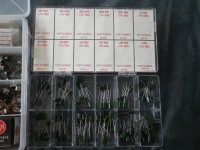
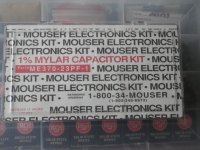
Mylar cap kits
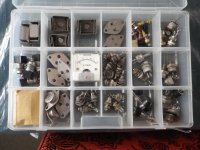
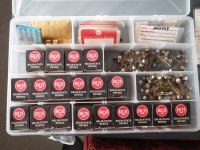
More assortments in plastic trays. No two trays though are the same size, just random size trays with random mixes of parts.
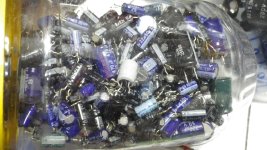
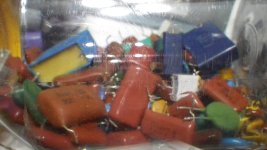
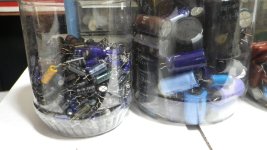
There are several hundred jars, cans, bags, and envelopes full of used parts like these. HIs wife said he would buy returned items back in the day and sit for hours removing parts from the boards and saving them. 90% of them are cleanly unsoldered, some are just cut off the boars leaving some pretty short leads.
The big question is are these even worth saving? I have no idea on their age or condition when removed and the thought that he may not have known about the issues with caps in the late 90's and early 00's. However, the few I pulled from a couple jars all tested out just fine.
There's a few boxes of capacitor 'assortments, 9 boxes of varioius transistors and larger diodes. and another tub of very small hardware and a tub full of transistor mounting kits.
At this point I've exhausted my 'on-hand' supply of small plastic bags and envelopes, so until I get some more, all I'll be doing is sorting out the rest of the IC chips and op amps into more of those 60 drawer cabinets. There's a tub full of them yet to go through.
Its really started to look like I need to set up another 'tower' of Akron bins to expand the Transistor space.


Mylar cap kits


More assortments in plastic trays. No two trays though are the same size, just random size trays with random mixes of parts.



There are several hundred jars, cans, bags, and envelopes full of used parts like these. HIs wife said he would buy returned items back in the day and sit for hours removing parts from the boards and saving them. 90% of them are cleanly unsoldered, some are just cut off the boars leaving some pretty short leads.
The big question is are these even worth saving? I have no idea on their age or condition when removed and the thought that he may not have known about the issues with caps in the late 90's and early 00's. However, the few I pulled from a couple jars all tested out just fine.
I figured I'd come back here and give an update. After nearly 6 weeks of digging, sorting, and inventorying all the new parts, I can say I finally put the last stack of Akron bins into place. It ended up being 8 stacks or towers in all. I ended up with two full 80 drawer towers with 2 each of resistors, transistors, and diodes, one with capacitors, with the larger caps getting put on open shelves, and one cabinet for switches, pots, and other small parts. The 60 bin cabinets, which started out as 8 had to be consolidated down to 6 with op amps and IC's, and two more for panel lights, LED's, and small bulbs. Lesser used items like resistor networks, terminal strips, fuses, thermistors, etc each got their own small drawer cabinets.
I had to seriously thing about the total weight, and all the tall cabinets got placed directly over the main support in the house. (I turned what was a home office into my repair room, and the cabinets are in a walk-in closet off of that room. I thought about doing it all above the garage but there's no ac or heat in there, the basement and upstairs are out because I'd be running up and down steps all day. If I were 20, that may have been different but in my 60's, I wanted it to be easy. After all this is a hobby not a business, although after the past few months, it's starting to feel a bit like work.
I can safely say I will never have to order a resistor for the rest of my life, and maybe not even transistors unless I run into something proprietary.
I also haven't gone through the used items or items marked New/Takeoffs either. Those boxes are still stacked on shelves in the garage.
I did bag and tag all the carbon comp resistors, of which there ended up being over 50 lbs of in all. For what ever reason, the assortment is as follows, 1/8w in 1k to 1m, 1/4w from .5 ohm to 5m, and 1/2w from .5 ohm to 500k, and 1w to 5w in smaller random lots. Many of the largest carbon comps read way out of spec, so they may or may not be worth keeping. the rest are all gold banded and read near perfect to spec. I tested samples of each value and only found a few values that were out of spec and those were unbranded and in addition to the branded versions of the same value.
Nearly all transistors are Motorola, RCA or Toshiba branded. The 1/4w carbon film resistors are mostly in 500 lots, with a few in much larger numbers, in what appears to be about 5 brands. I bagged them separate by brand but placed them by value in bins in numerical order by value in bags of 250 and 500. The larger extra lots got put on the shelf above. There's a fairly complete assortment of 1% metallic film resistors in both 1/4 and 1/2w, with another lot of them being marked numerically in 3ohm increments and in bags of 150 and 200. Those range from 1/8 to 2w .
About 20 transistor part numbers are in massive numbers, some in huge barrels, others in 30lb boxes.
Transistors got put first by type, then in numerical order. I didn't want to have to pawl through rows of small transistors to find a T0-3 or vice versa. My thought was that chances are I'll have a bad part in hand and its easier to go to the type first then find the part number. It also let me get more into the bins more uniformly.
Diodes are strictly numerically placed, regardless of type. Each bin is marked with the type and part number.
Caps are by value, low to high regardless of voltage with the larger power supply type caps being in boxes on the shelf.
I have my doubts as to how useful keeping 80 drawers worth of smaller caps will be worth, many are older but most are film type with some electrolytic, which most do seem to test okay, I'm not likely to use them in anything audio. (I bought a new Nichicon assortment two years ago which gives me a pretty good set of choices on hand, even so I still find myself ordering NP caps all the time for crossovers.
After all is said and done, I did manage to consolidate it all by more than 1/4 by simply making sure all of any one part was in the same location or cabinet. If I go to a cabinet, and its not there, then I know I don't have it. Before it meant digging through 20 boxes and still not being sure if there was one there or not and often ordering things I already had.
In laying out the cabinets I left about 10% space for additional items that may come along. adding a part number here or there won't likely ever mean re-tagging more than a few slots or the contents of one drawer.
Right now, all lists are on paper, but the plan is to slowly put it all on disk where it can be shown when needed. I just haven't figured out how I want to do that yet. There's a literal ton of stuff but likely not enough to justify any real software. I'm thinking maybe a basic Excel spreadsheet may do just fine. I do have an inventory program in the system but it was original intended as a liquor warehouse program. I'm not sure how it would convert to small parts vs cases and brand specific lot numbers.
Right now I'm just glad to have my two upstairs bedrooms back and most of my living room. (The living room still has five huge boxes of books and parts ID manuals spread out on a folding table. The plan is to put those I deem most important on a book shelf in with the parts, and the rest will get sold off or tossed. I really don't see the need to keep 300 copies of any one parts guide or 15 volumes of the same upgraded text book where in the later version covers everything that the first, to ninth version did only with some new added pages. Some of the really old books are certainly interesting, especially those from the early 1900's and a few from other countries as well. I did sell off all the Russian/Ukranian lanquage books, and most of the Spanish language books, but kept those that were brand specific to items built in those countries. (There's a few books from Brazil, (in Portuguese), and quite a few in German and Italian.
All the parts books from Motorola, NEC, RCA, etc are in English.
What boggles my mind is that this all came from bacially one place. I'm still trying to figure out if he was a collector, hoarder or if he really thought he'd use it all somehow. Although he did repairs he wasn't someone that struck me as ambitious and he'd refuse most work if you wasn't familar with it or the brand. He was more into ham radios and test equipment than audio. From what I was told he did TV's until the end of tubes.
Seeing all of thise after he has gone, I can't help but really wonder how much of a grip he had one what he had or where he had it.
So far I haven't tossed much, I just organized it so I know what is where and how many.
For right now I'm going to step back and try not to burn out dealing with it but I got approached by someone last week about cleaning out another massive lot of parts but I've yet to find out what all that includes or if its even of any interest to me.
I'm not sure I want to add to any of thise, unless its more along the line of audio parts specifically and from what I''ve been told the guy was more into radios than anything else. Its also not right down the block, its an hour away.
I'm getting the impression that there's not much market for these parts as is it, their value may only be my convenience in having them so I really don't want to spend another month hauling and sorting more stuff if its not of any use to me.
The few items I listed got zero replies on the sales sites in bulk. (I listed huge assortments of the Carbon Comp resistors that were in kit boxes but none got so much as a look or reply on FB, CL or Fleabay. I suppose the shipping alone is worth more than most would pay for a box or kit. (I had 10 per value/ 5,000 pc kits of Ohmite and Mouser branded Carbon comp resistors). I've since broke them down and sorted them all out by value in the name of space. Now all the carbon comp resistors are in bags broke down by value, and 20 values per bag. It saved massive amounts of space loosing the 60 flip top trays that held the incomplete assortments. If figured if they're going to stay here they might as well be a huge comprehensive assortment rather than a pile of small lots in boxes. Being in airtight zipper bags also keeps them safer for longer.
I had to seriously thing about the total weight, and all the tall cabinets got placed directly over the main support in the house. (I turned what was a home office into my repair room, and the cabinets are in a walk-in closet off of that room. I thought about doing it all above the garage but there's no ac or heat in there, the basement and upstairs are out because I'd be running up and down steps all day. If I were 20, that may have been different but in my 60's, I wanted it to be easy. After all this is a hobby not a business, although after the past few months, it's starting to feel a bit like work.
I can safely say I will never have to order a resistor for the rest of my life, and maybe not even transistors unless I run into something proprietary.
I also haven't gone through the used items or items marked New/Takeoffs either. Those boxes are still stacked on shelves in the garage.
I did bag and tag all the carbon comp resistors, of which there ended up being over 50 lbs of in all. For what ever reason, the assortment is as follows, 1/8w in 1k to 1m, 1/4w from .5 ohm to 5m, and 1/2w from .5 ohm to 500k, and 1w to 5w in smaller random lots. Many of the largest carbon comps read way out of spec, so they may or may not be worth keeping. the rest are all gold banded and read near perfect to spec. I tested samples of each value and only found a few values that were out of spec and those were unbranded and in addition to the branded versions of the same value.
Nearly all transistors are Motorola, RCA or Toshiba branded. The 1/4w carbon film resistors are mostly in 500 lots, with a few in much larger numbers, in what appears to be about 5 brands. I bagged them separate by brand but placed them by value in bins in numerical order by value in bags of 250 and 500. The larger extra lots got put on the shelf above. There's a fairly complete assortment of 1% metallic film resistors in both 1/4 and 1/2w, with another lot of them being marked numerically in 3ohm increments and in bags of 150 and 200. Those range from 1/8 to 2w .
About 20 transistor part numbers are in massive numbers, some in huge barrels, others in 30lb boxes.
Transistors got put first by type, then in numerical order. I didn't want to have to pawl through rows of small transistors to find a T0-3 or vice versa. My thought was that chances are I'll have a bad part in hand and its easier to go to the type first then find the part number. It also let me get more into the bins more uniformly.
Diodes are strictly numerically placed, regardless of type. Each bin is marked with the type and part number.
Caps are by value, low to high regardless of voltage with the larger power supply type caps being in boxes on the shelf.
I have my doubts as to how useful keeping 80 drawers worth of smaller caps will be worth, many are older but most are film type with some electrolytic, which most do seem to test okay, I'm not likely to use them in anything audio. (I bought a new Nichicon assortment two years ago which gives me a pretty good set of choices on hand, even so I still find myself ordering NP caps all the time for crossovers.
After all is said and done, I did manage to consolidate it all by more than 1/4 by simply making sure all of any one part was in the same location or cabinet. If I go to a cabinet, and its not there, then I know I don't have it. Before it meant digging through 20 boxes and still not being sure if there was one there or not and often ordering things I already had.
In laying out the cabinets I left about 10% space for additional items that may come along. adding a part number here or there won't likely ever mean re-tagging more than a few slots or the contents of one drawer.
Right now, all lists are on paper, but the plan is to slowly put it all on disk where it can be shown when needed. I just haven't figured out how I want to do that yet. There's a literal ton of stuff but likely not enough to justify any real software. I'm thinking maybe a basic Excel spreadsheet may do just fine. I do have an inventory program in the system but it was original intended as a liquor warehouse program. I'm not sure how it would convert to small parts vs cases and brand specific lot numbers.
Right now I'm just glad to have my two upstairs bedrooms back and most of my living room. (The living room still has five huge boxes of books and parts ID manuals spread out on a folding table. The plan is to put those I deem most important on a book shelf in with the parts, and the rest will get sold off or tossed. I really don't see the need to keep 300 copies of any one parts guide or 15 volumes of the same upgraded text book where in the later version covers everything that the first, to ninth version did only with some new added pages. Some of the really old books are certainly interesting, especially those from the early 1900's and a few from other countries as well. I did sell off all the Russian/Ukranian lanquage books, and most of the Spanish language books, but kept those that were brand specific to items built in those countries. (There's a few books from Brazil, (in Portuguese), and quite a few in German and Italian.
All the parts books from Motorola, NEC, RCA, etc are in English.
What boggles my mind is that this all came from bacially one place. I'm still trying to figure out if he was a collector, hoarder or if he really thought he'd use it all somehow. Although he did repairs he wasn't someone that struck me as ambitious and he'd refuse most work if you wasn't familar with it or the brand. He was more into ham radios and test equipment than audio. From what I was told he did TV's until the end of tubes.
Seeing all of thise after he has gone, I can't help but really wonder how much of a grip he had one what he had or where he had it.
So far I haven't tossed much, I just organized it so I know what is where and how many.
For right now I'm going to step back and try not to burn out dealing with it but I got approached by someone last week about cleaning out another massive lot of parts but I've yet to find out what all that includes or if its even of any interest to me.
I'm not sure I want to add to any of thise, unless its more along the line of audio parts specifically and from what I''ve been told the guy was more into radios than anything else. Its also not right down the block, its an hour away.
I'm getting the impression that there's not much market for these parts as is it, their value may only be my convenience in having them so I really don't want to spend another month hauling and sorting more stuff if its not of any use to me.
The few items I listed got zero replies on the sales sites in bulk. (I listed huge assortments of the Carbon Comp resistors that were in kit boxes but none got so much as a look or reply on FB, CL or Fleabay. I suppose the shipping alone is worth more than most would pay for a box or kit. (I had 10 per value/ 5,000 pc kits of Ohmite and Mouser branded Carbon comp resistors). I've since broke them down and sorted them all out by value in the name of space. Now all the carbon comp resistors are in bags broke down by value, and 20 values per bag. It saved massive amounts of space loosing the 60 flip top trays that held the incomplete assortments. If figured if they're going to stay here they might as well be a huge comprehensive assortment rather than a pile of small lots in boxes. Being in airtight zipper bags also keeps them safer for longer.
With all this, I'm thinking you're bound to have some high-value parts. Much of the problem is to identify which parts are high value so you can get some money out of them and make it more worth your while to go through all this.
You mentioned Radio Shack parts - some of the ICs can be valuable, such as MK50240 and MK50241 top-octave generators used in some organs, string synthesizers and Polymoog. These were only made for maybe 5 or 10 years. I recall buying a few of those from Radio Shack circa 1980, and more recently seeing prices like $80 on ebay. If you've got time to do it, put each of your list of IC types into ebay and google, and see if they're in demand. You mentioned 741s, if those or other ICs are in metal cans, they may be in demand (older military equipment may have specified these for higher reliability, and to repair them or build more, they NEED these parts).
Are these complete kits, (all the original parts, original packaging, assembly manual) in original boxes? Unassembled Heathkits (and perhaps others like Knight Kit and Eico) can go for a lot on ebay.I'm also finding boxes of 'kits' from various brands, including Heathkit and a few similar. Including a couple of amp kits probably from the 70's.
You mentioned Radio Shack parts - some of the ICs can be valuable, such as MK50240 and MK50241 top-octave generators used in some organs, string synthesizers and Polymoog. These were only made for maybe 5 or 10 years. I recall buying a few of those from Radio Shack circa 1980, and more recently seeing prices like $80 on ebay. If you've got time to do it, put each of your list of IC types into ebay and google, and see if they're in demand. You mentioned 741s, if those or other ICs are in metal cans, they may be in demand (older military equipment may have specified these for higher reliability, and to repair them or build more, they NEED these parts).
There are no 50XXX numbers at all, the ICs go up to 46,992 then to 75,004 There's 60 drawers full of 75XXX numbers and those go up to 92XXX or so.
There's a full cabinet and several boxes of 1975-77 dated Intel ICs and processors, plus a 60 drawer lot of early CMOS chips from Texas Inst. Nearly all of the IC's are pre-1980. A good many of the ICs seem to be mostly logic or computer related.
The kits are from about 10 different brands, only one Dynaco is an amp (ST120, which is built but its sounds terrible. Its built with mostly Mallory caps with lots of parts substitutions.
The Heathkits are signal generators, power supplies, and some radio/recievers. The boxes are flattened and rough, the parts were put in wood cigar boxes and the text portion of the boxes glued to the wood boxes.
There are kits from "Thompson", they include several Universal Tiger 'kits' but they're not much more than a couple of boards, an assortment of resistors, and a parts list to hunt down elsewhere. There are kits from the same source in clamshell packs, those are mostly electronic ignition kits which are mostly just bare printed boards and a list of parts, there's also a siren, a house alarm kit, several CDI ignition kits or 'Points saver kits".
It looks to me like he bought a bunch of kits, then copied the kits and built some items without the boards using bare boards and jumper wires. There are a few dozen of these experiments or kits in various states of assembly. There's also a few of those Radio Shack electronics experiment boxes for kids that look well used.
There doesn't appear to be much rhyme or reason as to what he had, other then the generic parts as a whole, there's not much in the way of audio specific anything despite there being about four dozen old receivers as well in various conditions.
The oldest receiver is a Fisher 400T, the newest a 40wpc 1982-83 or so Technics digital tune unit. Most are Radio Shack receivers.
The best receivers are a Pioneer SX650 and SX750, and a few 50wpc Sears Lxi models from the 80's.
The Radio Shack parts look like the remnants of a couple stores, all of the packaging is older, old logo style.
Its mostly replacement speakers, low end cassette tapes, electronics components, (resistors, transistors, diodes, connectors, thermistors etc. There's a few 28v and 42v transformers and about 30 lbs of automotive glass fuses, AGC and SFE, almost all 14 and 20a. There's also a box of 120 20a Maxi Fuses. There's also about 10 cases of 'Goldquest" car audio double RCA cables all with $34 price tags on them. An online search didn't turn up anything but a few items on eBay on the brand. I suppose they were something being sold in Radio Shack at some point. There's also Radio Shack brand 3ft RCA cables priced at $3.99. About 500 of them.
Most of the Radio Shack parts and cables are in black trash bags tied around wood coat hangers, apparently he had the bags hanging in one closet there.
There were lots of Advent, Boston, and Polk speakers, two or three of nearly all the common models. (Advent 4002, 5002, 5025, Boston T830, T930, T1030, Polk Monitor 5, 5jr, 7, 7, 10, and one pair of 12's that I already sold.
Then there's Radio Shack speakers, too many to list here. There's a few JBL speakers, LX150, LX300, LX600, CF100, CF120, CF150, L100, L112, and two pair of XPL200A's. Plus a handful of Emit era Infinity speakers, QA, QB, RSa, RSb, RSm, and a few polycell models that are missing parts. There's also 12 pair of RCA Dimensia speakers, most are SPK 500, and a few SPK350 and SPK400 bookshelf models. There were some smaller Criterion speakers and Harman Kardon speakers but those sold pretty fast, all of them were tiny book shelf models from the early 70's. The Sony speakers also went fast as did some of the smaller RS speakers.
I'll probably list most of the bulk quantity transistors, I certainly don't see ever using 100lbs of any one part number.
What I still can't figure out is how he managed to get hold of a quantity like that. One example of some barrel quantity is 2N3904. 2N3906, 2N5487, 2N5457. All are marked Motorola with one barrel of gold leads, and one with silver leads. One of the paper barrels has an inventory log sheet taped to it with a 2/23/1977. I believe the barrels are roughly the size of a 15gal oil drum. There are RCA TIP 30, 31, and 32 regulators in both beer case size boxes and two larger barrels of TIP30C and TIP32C. Those have a NJ address on them in Deptford, NJ dated 12-1979 and 5-01-1987.
A few of the barrels were never opened, still tape sealed with an RCA tape/label across the lids. Those are still in the garage, too heavy to haul in the house. I did manage to get some help to carry them upstairs into the apartment over the garage.
I figured I'd just start listing in small lots on eBay in the fall and for the next 20 years or so by the looks of it.
6 months ago when this all started I had zero intentions of getting into all this, certainly not on this scale.
Right now I'm glad to be done with the sorting, but in reality all I've done is make sure all of any one part number is in one location not in 15 different boxes, tubs, and drawers.
I actually cut down on the number of Akron drawers used for some items by simply combining duplicate bins. One example was 2N2222A transistors which had lots of 500 in 12 drawers. The same with the 2N5060 transistors and many Diodes. Some drawers were a random mix of simiar part numbers rather than being sorted by p/n. He likely couldn't find things and just ordered them over and over.
There's a full cabinet and several boxes of 1975-77 dated Intel ICs and processors, plus a 60 drawer lot of early CMOS chips from Texas Inst. Nearly all of the IC's are pre-1980. A good many of the ICs seem to be mostly logic or computer related.
The kits are from about 10 different brands, only one Dynaco is an amp (ST120, which is built but its sounds terrible. Its built with mostly Mallory caps with lots of parts substitutions.
The Heathkits are signal generators, power supplies, and some radio/recievers. The boxes are flattened and rough, the parts were put in wood cigar boxes and the text portion of the boxes glued to the wood boxes.
There are kits from "Thompson", they include several Universal Tiger 'kits' but they're not much more than a couple of boards, an assortment of resistors, and a parts list to hunt down elsewhere. There are kits from the same source in clamshell packs, those are mostly electronic ignition kits which are mostly just bare printed boards and a list of parts, there's also a siren, a house alarm kit, several CDI ignition kits or 'Points saver kits".
It looks to me like he bought a bunch of kits, then copied the kits and built some items without the boards using bare boards and jumper wires. There are a few dozen of these experiments or kits in various states of assembly. There's also a few of those Radio Shack electronics experiment boxes for kids that look well used.
There doesn't appear to be much rhyme or reason as to what he had, other then the generic parts as a whole, there's not much in the way of audio specific anything despite there being about four dozen old receivers as well in various conditions.
The oldest receiver is a Fisher 400T, the newest a 40wpc 1982-83 or so Technics digital tune unit. Most are Radio Shack receivers.
The best receivers are a Pioneer SX650 and SX750, and a few 50wpc Sears Lxi models from the 80's.
The Radio Shack parts look like the remnants of a couple stores, all of the packaging is older, old logo style.
Its mostly replacement speakers, low end cassette tapes, electronics components, (resistors, transistors, diodes, connectors, thermistors etc. There's a few 28v and 42v transformers and about 30 lbs of automotive glass fuses, AGC and SFE, almost all 14 and 20a. There's also a box of 120 20a Maxi Fuses. There's also about 10 cases of 'Goldquest" car audio double RCA cables all with $34 price tags on them. An online search didn't turn up anything but a few items on eBay on the brand. I suppose they were something being sold in Radio Shack at some point. There's also Radio Shack brand 3ft RCA cables priced at $3.99. About 500 of them.
Most of the Radio Shack parts and cables are in black trash bags tied around wood coat hangers, apparently he had the bags hanging in one closet there.
There were lots of Advent, Boston, and Polk speakers, two or three of nearly all the common models. (Advent 4002, 5002, 5025, Boston T830, T930, T1030, Polk Monitor 5, 5jr, 7, 7, 10, and one pair of 12's that I already sold.
Then there's Radio Shack speakers, too many to list here. There's a few JBL speakers, LX150, LX300, LX600, CF100, CF120, CF150, L100, L112, and two pair of XPL200A's. Plus a handful of Emit era Infinity speakers, QA, QB, RSa, RSb, RSm, and a few polycell models that are missing parts. There's also 12 pair of RCA Dimensia speakers, most are SPK 500, and a few SPK350 and SPK400 bookshelf models. There were some smaller Criterion speakers and Harman Kardon speakers but those sold pretty fast, all of them were tiny book shelf models from the early 70's. The Sony speakers also went fast as did some of the smaller RS speakers.
I'll probably list most of the bulk quantity transistors, I certainly don't see ever using 100lbs of any one part number.
What I still can't figure out is how he managed to get hold of a quantity like that. One example of some barrel quantity is 2N3904. 2N3906, 2N5487, 2N5457. All are marked Motorola with one barrel of gold leads, and one with silver leads. One of the paper barrels has an inventory log sheet taped to it with a 2/23/1977. I believe the barrels are roughly the size of a 15gal oil drum. There are RCA TIP 30, 31, and 32 regulators in both beer case size boxes and two larger barrels of TIP30C and TIP32C. Those have a NJ address on them in Deptford, NJ dated 12-1979 and 5-01-1987.
A few of the barrels were never opened, still tape sealed with an RCA tape/label across the lids. Those are still in the garage, too heavy to haul in the house. I did manage to get some help to carry them upstairs into the apartment over the garage.
I figured I'd just start listing in small lots on eBay in the fall and for the next 20 years or so by the looks of it.
6 months ago when this all started I had zero intentions of getting into all this, certainly not on this scale.
Right now I'm glad to be done with the sorting, but in reality all I've done is make sure all of any one part number is in one location not in 15 different boxes, tubs, and drawers.
I actually cut down on the number of Akron drawers used for some items by simply combining duplicate bins. One example was 2N2222A transistors which had lots of 500 in 12 drawers. The same with the 2N5060 transistors and many Diodes. Some drawers were a random mix of simiar part numbers rather than being sorted by p/n. He likely couldn't find things and just ordered them over and over.
You've accomplished a lot just by getting everything sorted. Fortunately it appears most things were already sorted into smaller batches.
So this guy did electronics repair ... did he make a lot of money doing it, or did he also have some other job/work/career for income? It appears he spent a large fortune on buying all these parts.He likely couldn't find things and just ordered them over and over.
That's incredible. I've never heard of anybody hoarding that many parts. Maybe he went to bankrupt company sales and purchased there? Looks like you can setup shop competing with Mouser and Digikey 🙂 My advice is to put all the part numbers, quanties and locations into a database. That'll save you some time in future. You're gonna have to sell them in bulk packs, there's no way you can muck about selling 1's or 2's.
Most of the items were in jumbled up piles of mixed p/n's. They were marked as being sorted but when I dug into them they were a mix of five or six p/n's all just dumped into one bin. What I found was that if a bin was marked 2N3906, it contained 2N3904, 2N5087, and 2N2222A transistors all mixed up, when I went to say the 2N5087 bin, I'd find nearly the same mix of the same numbers. It was as if he dumped incoming parts into the wrong bins over and over leaving a complete mess.You've accomplished a lot just by getting everything sorted. Fortunately it appears most things were already sorted into smaller batches.
So this guy did electronics repair ... did he make a lot of money doing it, or did he also have some other job/work/career for income? It appears he spent a large fortune on buying all these parts.
The guy that had all this was retired for as long as I knew him, I don't ever remember him having a job to go to. He was always home, even during the week so I sort of just figured it was all his idea of a retirement hobby.
For all I know he got it the same way i did but I did find quite a few receipts for some pretty big orders.
What doesn't make sense is he bought the same parts in huge quantities over and over. The receipts range from 1954 to 2004, and from $12 to $23k. Most of the order sheets had his address on them and he lived there since the early 50's. It looks like he bought at least some of it himself from various suppliers. What makes no sense is that there are repeat orders for the same p/n's from five or six sources in huge quantities over a 20 year or so period. All of the parts in the large quantities show as being bought from several of about 5 sources. There are some receipts too for the same parts bought in smaller assortments.
There's a few dozen assortments in clear trays each with 5 p/n's in each, but none are the exact same p/n's but as a lot, all of those 'assortments though contain 6 of 8 total p/n's in 2500 quantities. They're also the same numbers that are in such huge numbers in the barrels.
I figure some items may have been swap meet or show buys, and maybe some auction items but things like the boxes of variable resistors, switches, and rolls of resistors all show up on the receipts from a supplier in PA.
The downside of this lot is that about half or more of it is not applicable to audio.
My main goal was to get everything in some sort of order so I have half a chance of finding a part when I need it, whether to use or sell. The large quantities need to be knocked down or else they'll just sit here for ever. I can see maybe needing a few here and there of any of those parts but never 500lbs of any one part.
I think a lot of the mixed bins were the result of carely picking of parts but others were just a matter of dumping newly added parts in what ever bin had space with no concern of ever finding it again. The smaller drawers were the same way. Only one of the larger small drawer cabinets were bought as assorments, the rest were random and out of order. Some of the larger Akron bins were sorted by first digit, putting 1Ω, 10Ω, 100Ω, 1K in the same bin, and 2, 20, 200 etc in the next. but the divided sections were often mixed up with totally misplaced values. Sorting through and organizing the resistors and transistors took the longest because every bin and ever lot had to be gone through.
I even dumped out the barrels because two of them turned up to have more than one part number in them but were separated by sheets of cardboard. They filled one barrel about 1/3 of the way, dropped in a sheet of heavy brown paper, then another 1/3 of it was another part number topped with another sheet of paper, then the rest was a third p/n. Another barrel had bags of various other parts buried under the parts on the label. After sorting through those two barrels it turned out to be one full barrel of the marked p/n and 38 other p/n's. Another open barrel had rougly 1/8 of the contents removed but those were found in two 12x12" boxes stored elsewhere in the lot.When I opened that particular barrel there was a transistor tester and Fluke meter on top of the transistors remaining in the barrel and a set of unknown car keys. His daughter had no idea what the keys fit, and said they didn't fit anything he ever owned. One barrel was still strapped to a handtruck and sitting in the middle of the room. The handtruck was brand new with tags but over 30 years old and covered in dust as if it had sat there for decades despite other items all around it were newer. It was as if he hauled it into the house and back into that room and it just sat there for years. Things eventually got piled ontop of it also collecting dust for years.
The rolls of resistors were found all over the place, not all in one spot, despite being all identical. One in the shop area, one ontop of one shelf, two on the floor in the corner, and five more upstairs in another room laying atop a stack of boxes of more parts.
There are still more amps and receivers I have to sort through too, about 200 or so. A good many are just black plastic models from the 90's but a good many are decent units that if they need repair may be worth fixing. He definitely had a thing for Radio Shack and Realistic though. There's a half dozen STA2000, STA2100, STA2100D receivers and a a dozen others in the 50wpc and up class.
- Home
- Design & Build
- Parts
- Organizing large numbers of parts and components?